This pH meter has a large LCD display that shows you the readings in large figures, making it convenient to read under different light conditions. Plus, it comes with a backlight that will change colors depending on pH levels.
It drains batteries rather fast.
The Apera Instruments AI311 PH60 Premium pH Tester Kit is one of the most efficient devices for pH testing. Thanks to the glass bulb probe design, the meter makes ultra-accurate measures no matter the temperature.
Portable
-2.0 to 16.0 pH
0.01 pH
±0.01 pH
32 - 122 °F
4 x AAA batteries
1.6" x 1.6" x 7"
4.7 ounces
2 years warranty (6 months for probe)
Owing to the lock function, you'll be able to save test results on the screen and read them later. The meter also shows the temperature and the charge of the batteries.
It comes without a carrying case.
The VIVOSUN 3-in-1 is an irreplaceable tool for those who want to get all the information about the drinking water. In addition to pH and temperature, this model measures the number of dissolved solids in water (TDL).
Portable
0.0 to 14.0 pH
0.01 pH
±0.1 pH
32 - 140 °F
3 x 1.5V LR44 button cell
1.5" x 1.5" x 7.2"
3.9 ounces
1 year
With the AI209 PH20, you get a bunch of useful tools for simpler operation and transportation. There is a lanyard in the box, which allows you to keep your meter at hand.
The calibration may be a bit challenging.
This pH meter allows you to get very accurate readings. Whether you need to measure the pH of potable water, aquarium, or brewer's wort, the AI209 will assist you!
Portable
0.0 to 14.0 pH
0.1 pH
±0.1 pH
32 - 122 °F
4 x AAA batteries
1.2" x 1.6" x 7"
3.8 ounces
2 years
Boasting a super accurate rate, this tester allows for very precise readings. Thanks to the ATC function, the temperature fluctuations don't influence the results of your tests.
It might seem a bit slow.
The Dr. meter pH100 is suitable for laboratory practices. Thanks to its high accuracy, you will always be able to count on it knowing the testing results are correct.
Portable
0.0 to 14.0 pH
0.01 pH
±0.02 pH
32 - 122 °F
4 x 1.5V LR44 button cell (AG13)
0.83" x 1.42" x 7.2"
3.1 ounces
1 year
The Jellas JLPH01 is a pocket-size meter, thus it is very convenient to use on-the-go. Plus, owing to its intuitive control, the device is pleasant to use.
It measures only pH balance.
Are you looking for an affordable and accurate pH meter for testing your tap or aquarium water? If yes, this device may be just the right one. Despite its low price, this tool boasts high precision and provides results in mere seconds.
Portable
0.0 to 14.0 pH
0.1 pH
±0.1 pH
32 - 122 °F
3 x 1.5V LR button cell
0.79" x 1.22" x 5.94"
1.76 ounces
1 year
This site is a free online resource that strives to offer helpful content and comparison features to its visitors. Please be advised that the operator of this site accepts advertising compensation from certain companies that appear on the site, and such compensation impacts the location and order in which the companies (and/or their products) are presented, and in some cases may also impact the scoring that is assigned to them. The scoring that appears on this site is determined by the site operator in its sole discretion, and should NOT be relied upon for accuracy purposes. In fact, Company/product listings on this page DO NOT imply endorsement by the site operator. Except as expressly set forth in our Terms of Use, all representations and warranties regarding the information presented on this page are disclaimed. The information which appears on this site is subject to change at any time. More info
Apera Instruments AI311 PH60 Premium
Premium pH Meter
The Apera PH60 can be called one of the most user-friendly and reliable pH meters on the market. The device is ultra-accurate (±0.01 pH) and works in a wide range of -2.00 to 16.00 pH, 32 to 122˚F (0 to 50˚C). It is equipped with a replaceable probe, which is a very nice touch. You won't have to purchase a new tester when the service life of the sensor is over. By the way, this particular model can operate for about 2 years under proper use and maintenance.
A huge benefit of being able to replace the probe is that you can switch between sensor types and test a wider variety of liquids and solids. The PH60 comes with a glass bulb sensor for measuring liquids like water in your pool, drinking water, juice, brewing, and aquarium water. If you want to test food like rice for sushi, for instance, or examine the soil in your garden, you can attach a spear sensor to the meter. This model is also compatible with flat sensors by Apera. With a flat sensor, you can get micro-volume samples and even measure your skin pH.
Moving on, there is a variety of measures the Apera PH60 can do for you. To specify, it can measure ORP (Oxidation-Reduction Potential), temperature, and has the ATC (automatic temperature compensation) that lets you get accurate readings regardless of the liquid temperature as long as it is within the range of 32 – 122˚F.
This pH meter is also a quite user-friendly device. It has a large three-color display and three buttons underneath it. They are pretty responsive and easy to operate. To enter some settings, you should long-press the menu button and then short press the mode button. By doing so, you'll be able to switch between P1-P2-..P7 settings and calibrate the meter, set pH values for the alarm, turn on the backlight of the screen, select a temperature unit, and turn on the auto-lock function. The latter option locks stable readings on the screen so that you can read them later.
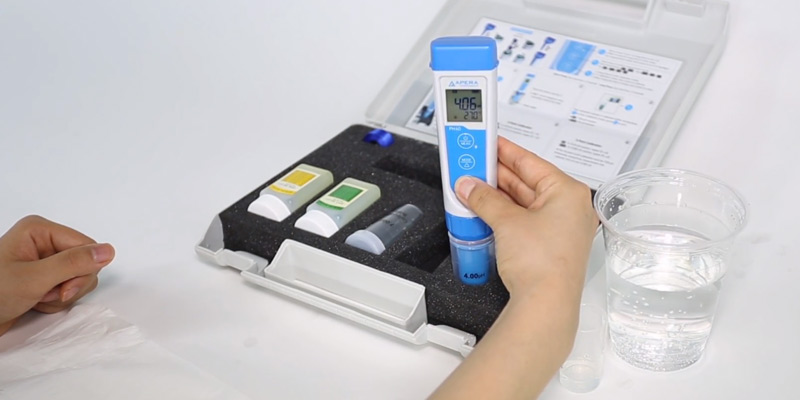
Everything Included
Unlike its rivals, the Apera PH60 pH meter comes with a generous set that includes two reusable buffer solutions (pH 4.0 and pH 7.0), two calibration bottles, and a lanyard. The included carrying case is also pretty good - it is made from sturdy plastic with foaming on the inside. It holds all the items firmly in place and has a hollow space for holding calibration bottles or the pH meter itself.
Under the top lid, there are detailed instructions on how to use and calibrate this model. There is also a laminated cheat sheet included. As you see, the folks behind the company have done their best to make sure their users will get a top-quality product.

Additional Info
| Last updated price | $79.75 |
| Stock | In stock |
| ASIN | B01ENFOIQE |

VIVOSUN 3-in-1 Digital
Ultra Accurate pH Meter
The Vivosun 3-in-1 pH meter is a pocket-size tester that offers high accuracy and effortless operation, allowing you to test quite a variety of liquids with different temperatures due to the ATC function it supports. It also gives you three types of readings: pH, temperature, and TDS (total dissolved solids - inorganic and organic substances such as minerals, salts, ions, and metals that can be found in liquids including drinking water). The latter reading is especially useful, as it will let you stay on a safe side, making sure the maximum of dissolved solids in your drinking water doesn't exceed the recommended norm.
Next, this meter is very easy to calibrate. Coming with three buffer solutions (4, 7, and 10 pH), it basically includes everything you need so you will not need to buy extra calibration solutions additionally.
Taking a detailed look at its specs, the Vivosun meter doesn't trail behind the rivals, letting you test acidic, neutral, and alkaline liquids in a range of 0 - 14 pH. What's more, the unit automatically identifies the pH level of a calibration solution, making the adjustments quick and easy even for a novice. Contributing to the ease of use is a lock function that memorizes test results letting you read them later.

Intuitive to Use
The Vivosun 3-in-1 pH meter has a very simple design but boasts exceptional durability. The electrode of this model is manufactured from a composite glass known for its sturdiness, fast response, and precision.
Speaking of the construction in general, the unit is made with a slightly narrow handle for a more convenient grip and equipped with a large backlit LCD display that shows test results, battery charge, and the temperature of a liquid you test. There are three responsive control buttons neatly arranged under the screen - you can use them to switch between modes and to calibrate the device. The meter is also fairly lightweight thanks to the button cell battery type it uses (needs 3 of them). The manufacturer kindly supplies the batteries with the meter. Besides them, the box includes 3 buffer solutions and a user manual. All this makes the Vivosun 3-in-1 a great pH meter for laboratory testing and for home use.
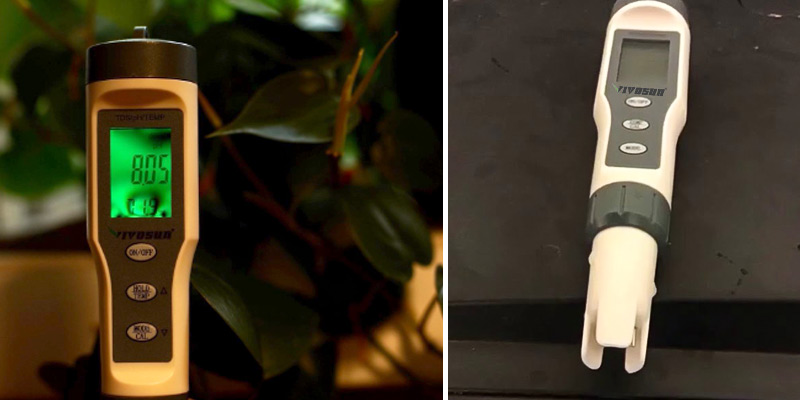
Additional Info
| Last updated price | $37.99 |
| Stock | In stock |
| ASIN | B08228CNGT |
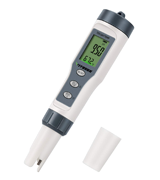
Apera Instruments AI209 PH20
All You May Need Is in the Box
With the Apera Instruments AI209 PH20 tester, you get everything you may need for accurate and effortless pH testing. Actually, the set includes a durable carrying case, 4pH and 7pH buffer solutions, two batteries, and a lanyard that you can use to hang your pH meter around your wrist and keep it at hand, which is especially convenient when you need to make several tests at a time. There is also a soft housing gasket in the package; it's made from mild foam-rubber for safer storage and transportation of the tester.
Aiming to produce a device that would be easy to use by novices and professionals alike, the manufacturer has equipped the AI209 PH20 with detailed guidance. The manual gives comprehensive instructions on the operation and calibration of this model (which is quite simple and fast). All you need to do is take a buffer solution, dip the meter probe into it, and press a start button. The device will recognize the pH level of the buffer automatically. When the test is over, you will need to rinse the probe in distilled water to get it ready for the next testing.
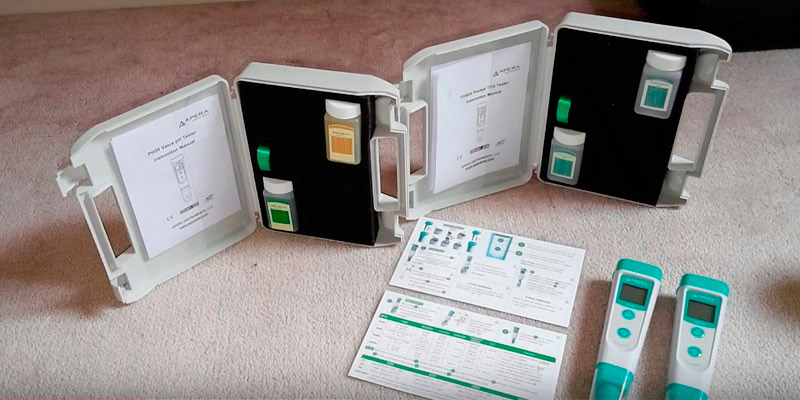
Reliable in Every Respect
The Apera PH20 is made durable and very accurate. It has a glass sensor with a ceramic junction that guarantees precise readings of liquids no matter the temperature. So whether you test cold drinking water or hot water in your jacuzzi, you will get equally accurate results. By the way, the housing of the meter is completely water-resistant. The meter fully corresponds to the IP67 standard and can be used almost under any conditions. The device also comes with a protective cap for the sensor. It protects the probe from possible damage during storage and transportation. Irreplaceable attribute for users who travel a lot.
Moving on, the AI209 has an easy-to-read 180˚ display that shows the information about acidity/alkalinity and water temperature. The display is large and bright, so it is easy to read under any light conditions.
As for the power supply, this pH meter is powered by four AAA batteries that come in the box. According to the manufacturer, the device ensures 2000 hours of operation without a need for battery replacement. On top of that, the manufacturer offers a 2-year warranty that in combination with high accuracy of ±0.1 pH makes the Apera PH20 a very trustworthy device.

| Last updated price | $49.75 |
| Stock | In stock |
| ASIN | B01ENFOHN8 |
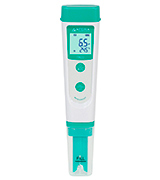
Dr. meter pH100 0.01 Resolution
If You Want to Get Precise Data
The Dr. meter pH 100 is surely one of the best pH meters on the market today thanks to its ultra-high accuracy. When maintained properly, the meter provides you with ±0.02pH accurate data. For the same reason, it is a popular device for laboratory testing as well.
The measurement range of this model is 0 to 14 pH. This meter has the ATC function so it can be used at different temperatures (the temperature range makes 32-122ºF) safely. As for the time of measuring, the PH100 needs from 30 to 60 seconds to show the results. The reading time mostly depends on the temperature of the probe and the solution you want to measure. When the difference is significant, you have to wait longer. Once the meter determines the accurate pH and temperature of a liquid, it displays the results on an easy-to-read LCD screen. Both readings are shown at a time.
Operating the meter is very easy since there are only 3 control buttons underneath the screen - on/off, calibration, and hold buttons. So, to make a test, you need to press the on/off button, submerge the probe into the liquid you want to test, stir it for a few seconds and wait until the result is depicted on the screen. Then, you should rinse the probe in distilled water and wipe it out. Calibration is also quite easy with this unit - it supports 3-step calibration and automatically detects the buffering solution.

For Users Who Value Accuracy
In addition to high accuracy and user-friendly design, we like that this model comes well-equipped. That is to say, with the Dr.Meter PH100, you get six calibration packets (two with 4.0 pH, two with 7.0 pH, and two with 10.0 pH), and a special carrying case for safer and easier storage. The manufacturer has also supplied this device with eight LR44 button cells (the meter uses 4 batteries at a time). They are quite small, which makes the Dr. meter pH 100 pretty lightweight (only 3.1 ounces). This design also means that you can quickly replace the batteries when the charge is over. You will also find a small user manual under the top lid.
All in all, the Dr.Meter PH100 is a reliable tool for users who value accuracy. It might slow down a little when you test very hot or cold liquids but still makes very accurate measures. Besides, considering its price, this meter is a real bargain.
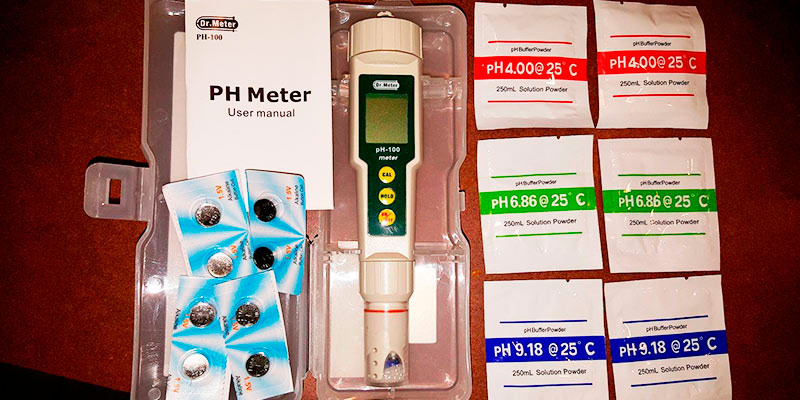
| Last updated price | $0.00 |
| Stock | May be out of stock |
| ASIN | B00ST3VTQ4 |
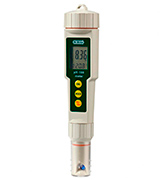
Jellas JLPH01
Low-Cost and Portable
The Jellas JLPH01 is another compact and affordable pH meter. Right off the bat, we would like to note that it can measure just the pH of the water, not the temperature. However, it always delivers accurate data. So, if you are on a budget but want to get an accurate tester for home use, this model may be right up your alley.
The JLPH01 tests drinking water, water in your pool, aquarium, and even spa. Due to its straightforward design, this device is very easy to use. It has a single button for turning on/off and a small but well-readable display that shows you the pH level of the tested liquid. This meter has a standard accuracy level (0.1 pH) and pH range (0 - 14 pH). Its temperature range is 32- 122°F, so you can measure the pH of cold and hot liquids alike.
Moving on, we would like to say that this is a pocket-size meter that is only 5.94" long and 0.79" high. It is lightweight and has a pocket clip on the rear for a convenient use on-the-go. Next to the pocket clip, you will notice a small hole - a calibration trimmer. You need to regulate it with a screwdriver (comes in the box) from time to time.
To sum up, the Jellas JLPH01 is a basic low-cost pH meter. It gives accurate readings and is fairly easy in use. So if it sounds like the pH meter you’ve been looking for, then the Jellas model is a great choice.
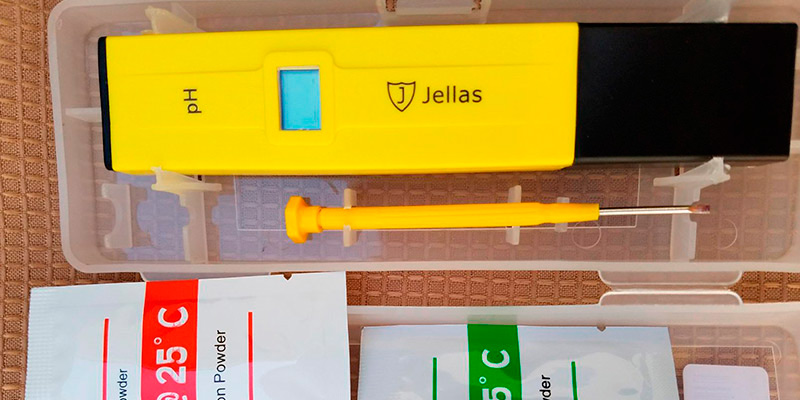
Calibration Process
As we've mentioned, this unit comes with a calibration trimmer, meaning you will need to calibrate it manually. That said, this process is not complex at all. Here are three simple steps to follow to calibrate your pH meter:
- For starters, take a calibration powder and make a standard buffer (a solution that has constant pH balance when you dilute it, concentrate it, or add acids).
- Then, dip the electrode into this buffer solution (77°F temperature) and wait for a minute.
- Finally, adjust the trimmer with a calibration screwdriver (included in the box). As we have mentioned above it is located on the backside of the tester. You need to regulate it until the reading on the display corresponds to a standard buffer solution. For example, if you have a 4.0 pH solution, you should turn the trimmer until you see 4.0 on the screen.
It may seem obvious, but you should always read the manual before you start using your instrument. Undoubtedly, if you follow care and maintenance instructions, the device will serve you for a longer time.
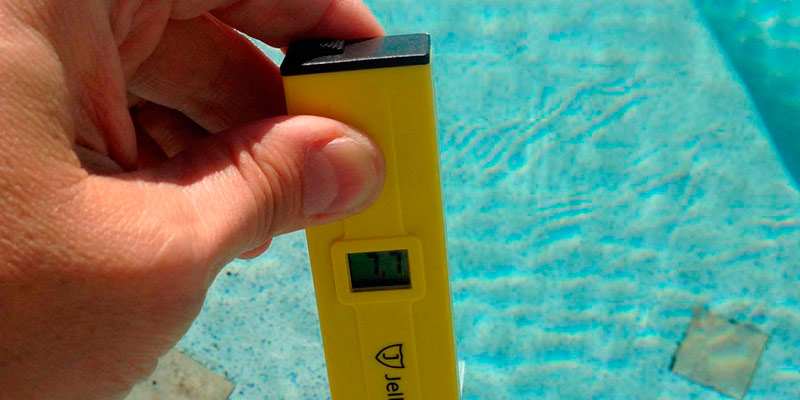
| Last updated price | $22.71 |
| Stock | In stock |
| ASIN | B00YBUH4RC |

What Is a pH Meter?
A pH meter is a special device that measures the pH (acidity or alkalinity) of liquids and semi-solid substances. As a rule, it consists of two basic components: electrodes (glass and reference) and a display (usually with a numeric pH reading). When you dip electrodes into the water, the device measures the voltage between them and then convert pH value onto a display. This result is usually measured in the range of 0 to 14, where 0 is acid, 7 is neutral, and 14 is an alkaline solution. If you want to get the most accurate readings possible, you should calibrate your meter by immersing it into a buffer solution. As for the fields of application, this device will be helpful not only for chemists but also for those who are interested in the quality of water and its alkalinity or acidity. Once you're on this page, we'd like to offer you to look through our selection of multimeters and emf meters among which you may find an appropriate model for some other needs.
What Features to Compare
Type
The types of pH meters vary; however, we can distinguish the most common of them, which are portable and stationary models.
- Portable devices are the most popular since they are accurate, lightweight, and space-saving, and you can always keep them at hand. Plus, they are pretty handy for occasional water testing.
- Stationary meters can be battery-powered and grid-powered. They usually have an external electrode and allow you to take precise measurements under laboratory conditions.
Accuracy
After you have decided on the type of meter you need, check its accuracy. Highly precise meters have the 0.01 pH and are ideal for scientific/laboratory practices, for example. Some models have more than 0.1 pH accuracy and are good for home use. We would like to point out that top pH meters can also measure temperature. If you want to have such an option, pay your attention to this feature too.
Max/Min Value
The pH range is another important thing to consider. As a rule, most devices have a range from 0 to 14 pH. If you usually deal with liquids that have a high pH level, set your eyes on models which have a range like that.
ATC, TDS, and Other Extras
While every pH meter tests liquid pH, other measuring values vary from one model to another. The pricier the tester is, the more features it usually has. ATC and TDS are a few of them. ATC stands for the automatic temperature compensation and allows you to test liquids with different temperatures (often in a range of 32-140 F). TDS measure tells you the level of dissolved solids and oxygen in the water.
A pH meter can also have some other useful features like the lock function to hold the results on the screen, alarms for high/low measures, automatic shut-off, and more.
Calibration
Calibration is another important aspect to consider. It can be either manual (when you need to adjust the calibration trimmer with a screwdriver) or automatic (when you need to press a calibration button, the meter automatically detects the pH of a buffer solution, and then you should press a button again to memorize the pH level). In both cases, calibration is simple and comprehensive. The only difference is the time you spend on it. You should also check the package of the pH meter for buffer solutions. Some manufacturers include mixed buffers to the box, while others put powders that you need to dilute with water by yourself.
Features
Last but not least, check out the weight and dimensions of the chosen model, as these numbers should tell you about how convenient the meter will be in use. You may also want to consider buying the meter that doesn't have a learning curve, comes with a display, and has user-friendly controls.
FAQ:
Q: What pH buffer should I use?
A: As you know, a buffer is a solution used for calibration of pH meters. This procedure is essential if you want to get accurate measurements. In order to make these readings maximally precise, you need to follow a few simple rules. You should use only fresh buffer solutions and they must be of the same temperature as the samples are. For instance, if all your samples are 50°, you should heat buffers up to the same temperature.
Q: How can I get reliable pH measurements?
A: Well, first of all, calibrate your tester before every use and try to use only fresh buffers. Then, you can use temperature compensation option or just keep your samples and buffers at the same temperature. Also, always soak new electrodes before use into a 50/50 compound of saturated potassium chloride and pH 4 buffer.
Q: What is an automatic temperature compensation (ATC)?
A: ATC is an option on handheld testers. So far as all samples respond to temperature differently, you can hardly to adjust the meter for every pH change. Since temperature influences pH and may cause some errors, ATC allows a pH meter to compensate the temperature variations. In other words, this function guarantees you more accurate readings. For example, if you measure a sample without using the ATC, you will need to enter the temperature of the solution manually.
Q: How should I store an electrode?
A: You should store it in a special storage solution for short-term and between measurings. If you don't have one, you can use pH 4 or pH 7 buffers as an alternative. However, take note that you should never store an electrode in distilled/de-ionized water, since it might leach out electrolytes. As for long-term storage, you should keep an electrode dry. To rehydrate an electrode, dip it into a pH4 buffer for at least 30 minutes.
Q: What is the lifetime of a pH probe?
A: The lifetime of an electrode will depend on appropriate maintenance, storage conditions, and types of samples you measure. If you use your pH meter with dirty samples, high temperatures and pressures, its lifetime will be reduced significantly. However, with proper and regular maintenance, your pH meter will provide you with accurate data for a good while.
Sources:
1. How to Buy a pH Meter, wikiHow.
2. pH meter, Wikipedia.
3. The Secret to Well-Functioning pH Meters? (It's the Electrodes!), Cole-Parmer. March 16, 2017.
4. pH, Wikipedia.
5. pH Meter Buying Guide, eBay. March 3, 2016.
6. Chris Woodford pH meters, ExplainThatStuff. May 6, 2016.
7. How do pH probes work? Quora. June 10, 2016.
8. Steffi Magub How to Care for Your pH Meter, BitesizeBio.
9. How to Calibrate and Use a pH Meter, wikiHow.
10. Philip J. Carlson Why Is It Important to Calibrate a pH Meter and Its Electrodes Against a Buffer? Sciencing. April 24, 2017.


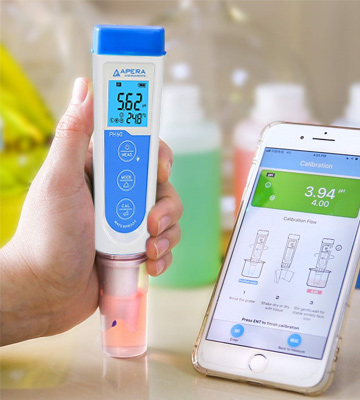
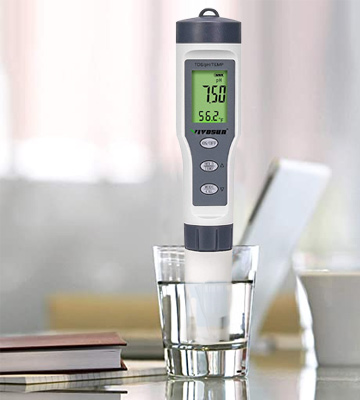

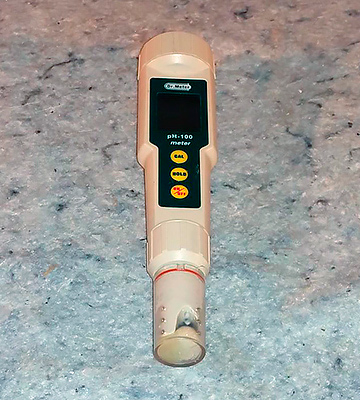
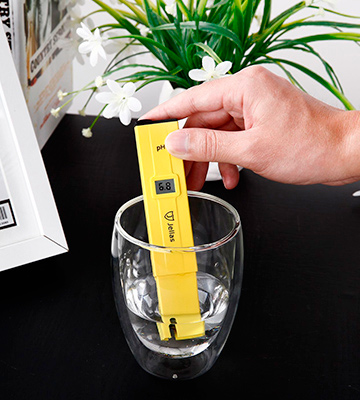

Your comment was successfully sent
Error! Please try again later